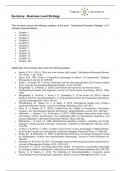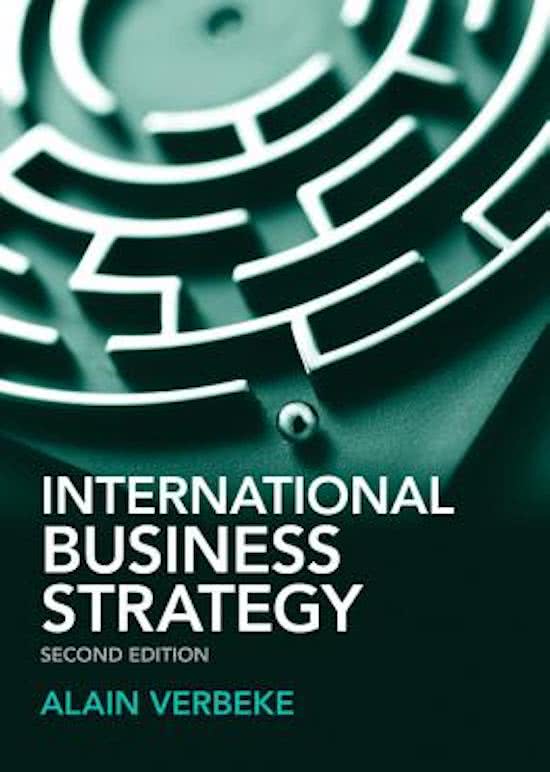Summary - Business Level Strategy
This summary covers the following chapters of the book; ‘’International Business Strategy’’ of A.
Verbeke (Second Edition):
• Chapter 1.
• Chapter 2.
• Chapter 3.
• Chapter 4.
• Chapter 5.
• Chapter 6.
• Chapter 7.
• Chapter 11.
• Chapter 12.
• Chapter 13.
• Chapter 14.
• Chapter 16A.
Additionally, this summary also covers the following papers:
• Benito, G.R.G. (2015), "Why and how motives (still) matter", Multinational Business Review,
Vol. 23 No. 1, pp. 15-24.
• Grant, R.M. 1991. Porter’s ‘Competitive advantage of nations’: An assessment. Strategic
Management Journal 12, 535-548.
• Guler, I., & Guillén, M. F. (2010). Institutions and the internationalization of US venture capital
firms. Journal of International Business Studies, 41(2), 185-205.
• Beugelsdijk, S., & Welzel, C. (2018). Dimensions and dynamics of national culture:
Synthesizing Hofstede with Inglehart. Journal of Cross-Cultural Psychology, 49(10), 1469-
1505.
• Beugelsdijk, S., Kostova, T., Kunst, V. E., Spadafora, E., & Van Essen, M. (2018). Cultural
distance and firm internationalization: A meta-analytical review and theoretical implications.
Journal of Management, 44(1), 89-130.
• Schellenberg, M., Harker, M. J., & Jafari, A. 2018. International market entry mode–a
systematic literature review. Journal of Strategic Marketing, 26(7), 601-627.
• Zhou, N., & Guillen, M. F. (2016). Categorizing the Liability of Foreignness: Ownership,
Location, and Internalization-Specific Dimensions. Global Strategy Journal, 6(4), 309-329.
• Hollender, L., Zapkau, F. B., & Schwens, C. (2017). SME foreign market entry mode choice
and foreign venture performance: The moderating effect of international experience and
product adaptation. International Business Review, 26(2), 250-263.
• Birkinshaw, J. & Hood, N. 1998. Multinational subsidiary evolution: capability and charter
change in foreign-owned subsidiary companies. Academy of Management Review 23(4),
773-795.
• Le Bas, C. & Sierra, C. 2002. ‘Location versus home country advantages’ in R&D activities:
Some further results on multinationals’ locational strategies. Research Policy 31, 589-609.
• Kedia, B.L. & Mukherjee, D. 2009. Understanding offshoring: A research framework based
on disintegration, location and externalization advantages. Journal of World Business 44,
250-261.
• Mudambi, R. & Venzin, M. 2010. The strategic nexus of offshoring and outsourcing decisions.
Journal of Management Studies 47(8), 1510-1533.
• Contractor, F.J. 2013. ‘Punching above their weight’; The sources of competitive advantage
for emerging market multinationals. International Journal of Emerging Markets 8(4), 304-328.
• Bondy, K. & Starkey, K. 2014. The dilemmas of internationalization: Corporate social
responsibility in the multinational corporation. British Journal of Management 25(1), 4-22.
,• Ruth V. Aguilera & Gregory Jackson (2010) Comparative and International Corporate
Governance, The Academy of Management Annals, 4:1, 485-556.
• Yann Algan & Plerre Cahuc (2014) Trust, Growth, and Well Being: New Evidence and Policy
Implications, Handbook of Economic Growth, Volume 2A, 49-12.
• John Hooker (2009), Corruption from a cross-cultural perspective, Cross Cultural
Management: An International Journal, Vol. 16 Issue: 3, pp.251-267.
, 1) Organizational matters – introduction to international strategy
What is international strategy, and what are some of the key elements of international
strategy?
General objective of strategy à achieving sustainable competitive advantage leading to
above-average economic performance.
This usually involves building upon firm-specific advantages (FSAs) such as core
knowledge, competencies, efficiencies, and business models.
International strategy à matching the internal strengths, or FSAs, with the opportunities
(can be markets, key knowledge outside your own country) and challenges (liability of
foreignness, the distances) found in cross-border environments; overcoming the
disadvantages of being a foreign company; capitalizing on the advantages of being a foreign
company and of having an international network.
MNEs = firms with economic operations located in at least 2 countries.
Example 1: Swapfiets
à providing bicycles as a service, they built upon their unique resources and capabilities
(business model, service excellence, distinctive branding, partnerships with suppliers).
Their international strategy à cities outside the Netherlands with the biggest cycling
infrastructure and culture (Copenhagen, Germany) à in cities with a similar mindset to
Dutch people; did they adapt locally? They encountered cultural differences, but they are
German regional managers for example.
Example 2: Apple
à building on unique resources and capabilities (technology, brand, complementary
products).
Their international strategy à they were successful in creating a competitive advantage
globally. There is a global market for smartphones and electronic products. They are heavily
reliant in global customers (60% sales from abroad). There are lots of global opportunities
for sourcing and manufacturing, a very global network; they have collaborated a lot with
rivals (ex. the screens provided by Samsung, Sony for the cameras, Toshiba for storage
devices, Intel for the chips). They are tapping into foreign knowledge and partnering,
investing in R&D overseas, building in pioneering technology that are being built in China
for example.
Example 3: IKEA
à building upon its unique resources and capabilities (design, unique business model,
brand).
Their international strategy à (like Apple) they rely on global opportunities for design,
sourcing, and manufacturing, and they have a global network of suppliers; they have global
customers; do they change much overseas? Some differences, no new products really, but
, they do redesign their stores in different countries, ex. Indian furniture – against humidity,
China - more balconies, glass size in the US.
The WHY, WHERE, WHAT and HOW of internationalization:
• WHY à the motives (the starting point):
• Market seeking à want to sell their products to new markets.
• Efficiency seeking à lower the cost of their operation.
• Resource seeking à access core resources abroad.
• Strategic asset seeking à ex. Apple in China to access the key knowledge
there, or companies setting up in Silicon Valley.
• WHERE à location choice:
• Attractiveness of country à connected to the WHY.
• “Distance” to home country
• WHAT à what activities are we thinking of internationalizing:
• Marketing & Sales
• Manufacturing
• Purchasing, extraction
• R&D
• HOW à the way in which we want to go, the benefits and costs:
• Export
• Set up a subsidiary
• Licensing
• Do we look for a partner (franchising, JV alliance)
• FDI – Brownfield / Greenfield
The WHY, WHERE, HOW and WHAT are really interconnected:






